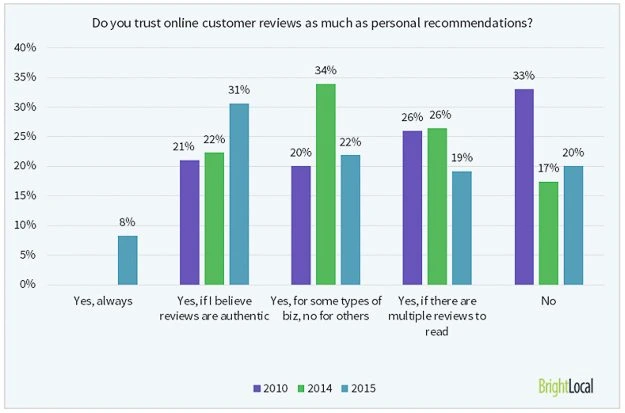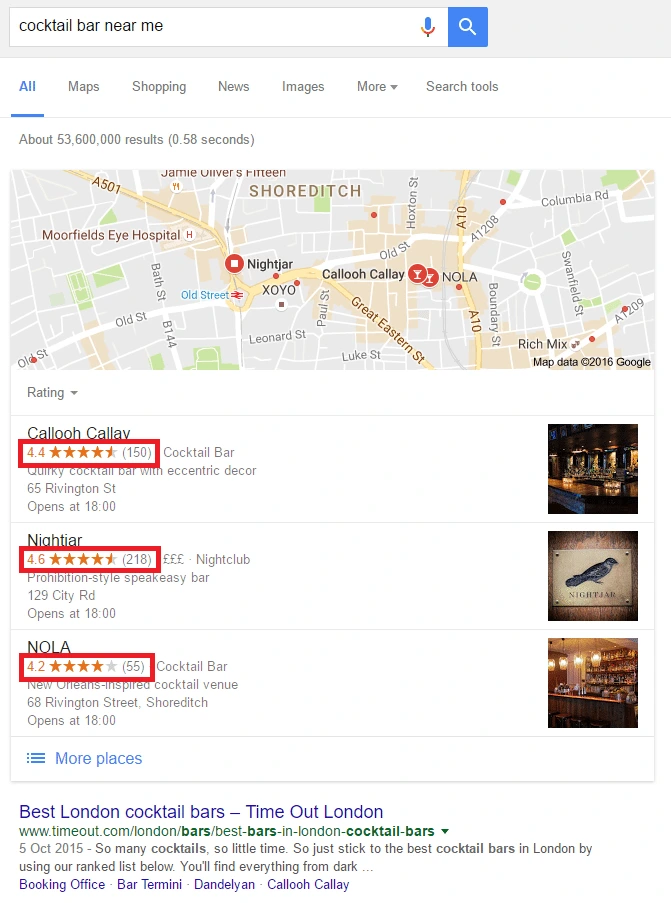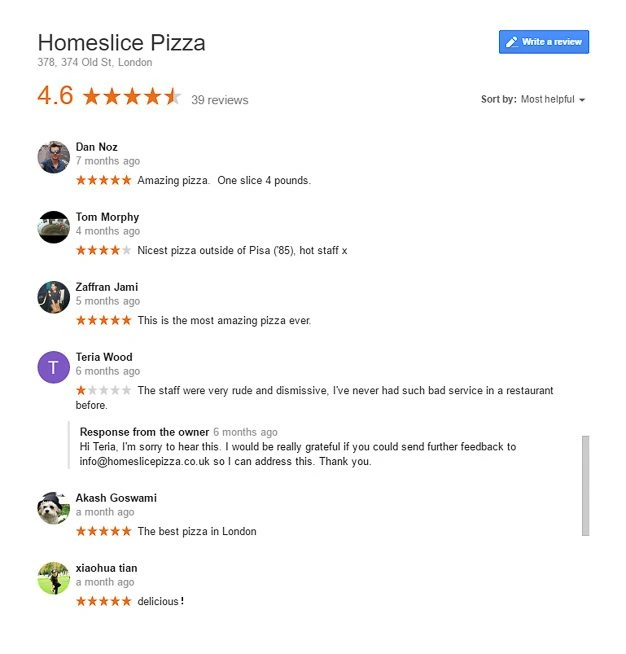
4 mins
OpenContent Marketing In The Time of COVID-19
5 mins
The rise of local search has placed more importance on reviews, rendering testimonials, once the king of social proof marketing, obsolete. But how can you maximise the potential of online reviews to elevate your brand?
8th September 2016

80% of people trust online reviews as much as word of mouth recommendations.
Social proof continues to be one of the most valuable marketing techniques available to a brand. In fact, 92% of consumers read product reviews before making a purchase. However, the evolution of the digital landscape has rendered testimonials, once the king of social proof marketing, obsolete. Instead, more importance is being placed on online reviews.
It’s a Friday night, you’re heading out for a meal with friends, but you haven’t yet decided where you want to eat. You come across two restaurants side-by-side, one which is empty and one which is full of customers enjoying their food. Which restaurant seems more appealing?
That’s the power of social proof; our natural human instinct to trust what we learn from the experiences of others. In online marketing, social proof is fundamental in building a positive brand image and ultimately attracting conversions.
Traditionally, consumer purchase decisions were influenced by information provided by the brand or by word of mouth recommendations from friends and family. Now, with the internet almost instantaneously available at their fingertips, customers can obtain large amounts of information without ever speaking to a salesperson.
Consumers have become digital explorers, seeking reviews and in-depth details online before purchasing a product. According to Bright Local’s annual Local Consumer Review Survey, 80% of people trust online reviews as much as word of mouth recommendations. Furthermore, 40% of people form an opinion of a brand or product after reading between 1 and 3 reviews.
 Source: www.brightlocal.com/learn/local-consumer-review-survey/
Source: www.brightlocal.com/learn/local-consumer-review-survey/
81% of shoppers conduct online research before visiting a website to make a purchase, which means purchase decisions have been made well before a customer stumbles upon your testimonials page.
Many businesses leverage social proof to market themselves online as leaders in their field. To boost their claim, many brands solicit testimonials from their customers. A selection of favourable testimonials are then displayed on a designated page of the brand’s website.
For many years, testimonials were a great way of building a positive brand image. However, in the age of the informed customer, the paradigm of teaching your customers about a product has been reversed. Now, customers visit your website knowing exactly what they want and what to expect of it.
Yes, customers want to read reviews of your products, but 81% of shoppers conduct online research before visiting a website to make a purchase. That means purchase decisions are made well before a customer stumbles upon your testimonials page. If they have decided to make a purchase, they’ll bypass straight past the testimonials. If they’ve decided otherwise, they won’t visit your site at all.
Since Google’s 2014 Pigeon update, which was designed to provide more accurate results relevant to a searcher’s location, online reviews have become an integral component of local SEO. Reviews and ratings can be extremely influential over consumer purchase decisions. Of the 92% of consumers that read online reviews, 48% will visit a website after reading positive feedback.
Reviews can be created and shared on third-party sites such as Yelp, TripAdvisor and Foursquare, while Google’s has its own reviews feature that’s increasingly influential in local search.
Unlike testimonials, reviews appear offsite and are likely to be discovered by consumers at the research stage of the buying cycle. Furthermore, online reviews paint a more objective image of a brand or product. Customers want to read authentic, unbiased and unfiltered reviews—much different to testimonials which are often curated and edited by the business to portray themselves immaculately.
Another bonus to reviews, particularly Google ratings and reviews, is that they can actually influence online visibility. When users leave feedback on Google, reviews are displayed on the company’s Google Business card, while ratings are aggregated to give the business its star rating.
According to Moz’s research into local search ranking factors, review signals such as quantity and diversity are significant. Ratings are also important—those with higher ratings are more likely to appear on Google’s local stack. Bright Local’s annual survey found that 94% of consumers will use businesses with four star ratings, compared to just 14% of consumers who would consider using those with a 1 or 2 star rating.
When users leave feedback on Google, reviews are displayed on the company’s Google Business card, while ratings are aggregated to give the business its star rating.
 Bright Local’s annual survey found that 94% of consumers will use businesses with four star ratings.
Bright Local’s annual survey found that 94% of consumers will use businesses with four star ratings.
Online reviews are here to stay and the influence they have on purchase decisions is only likely to increase. To elevate the brand through social proof, businesses must capitalise on customer feedback—failing to do so could be detrimental to sales performance. Here are five ways you can use customer reviews to your advantage:
Consider all of the review sites relevant to your business and set up profiles on them. The first port of call should be Google My Business (GMB) where you can claim a free business profile that appears in local and branded search. The reviews and ratings left here are those that can influence local search rankings. Other sites to consider include Yelp, Yahoo Local, TripAdvisor, Angie’s List, Trustpilot, CitySearch and FourSquare.
If you receive a negative review, use it as an opportunity to show your brand truly cares. Respond politely, apologise and provide advice on how the problem can be rectified.
The average customer is not going to spend time searching the web for places to leave a business review. It’s therefore important to make leaving feedback as easy as possible. On your website, add a call-to-action with links to each of your reviews profiles. Alternatively, ask customers to leave feedback in follow-up emails and newsletters, again with links to profiles included.
Unfortunately, humans are more inclined to discuss negative customer experiences than positive ones. However, 70% of unsatisfied customers will consider doing business with you again in the future if you respond to and resolve their complaint.

70% of unsatisfied customers will consider doing business with you again in the future if you respond to and resolve their complaint.
While it’s important to keep an eye out for negative feedback, don’t let positive reviews simply pass by. Reviews are a great way to initiate meaningful dialogue with customers—even a simple “thank you” can go a long way toward making customers feel valued.
To really make the most of positive reviews, share them on social media. Great tweets spread through the Twittersphere like wildfire, take advantage of it.
Schema local markup is a universally accepted markup language that makes it easier for search engines to digest important information, such as positive customer feedback.
Using schema in tandem with onsite reviews helps search engines find this information and display reviews of the company’s products or services in search results. Furthermore, schema can be used to identify links to various review profiles helping search engines to index them faster.
 Schema markup helps search engines to find business reviews and ratings. These may be displayed in search results.
Schema markup helps search engines to find business reviews and ratings. These may be displayed in search results.
Reviews can be a double edged sword for businesses. Poor reviews can lead to customers forming a negative brand perception, but positive reviews can really boost brand image. However, in a world where customers can obtain information at the touch of a button, an honest and authentic review is likely to have far more persuasive power than a biased and exaggerated testimonial.